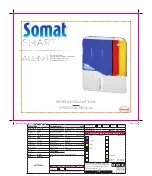
Specifi cations
EN 1149-5 : antistatic clothing
All garments from this range comply with the standard EN1149-5
(antistatic protective clothing – material tested according EN1149-
3). This means that the garments are designed to discharge
electrostatic charges in order to prevent the generation of
sparks that could cause fi re and/or explosions. However, these
requirements are not suffi cient in oxygen enriched fl ammable
atmospheres. Neither are the garments designed to protect against
mains voltages.
EN ISO 11612 : protective clothing to heat and fl ames
The clothing also complies with standard EN ISO 11612. The
performance levels are : A1, B1, C2, D0, E3 and F1. A1 means that
the fl ame spread is tested according the fi rst procedure described
in the standard; B indicates the performance for convective heat,
where 1 is the lowest level applicable for limited risks (highest level
is 3); C means the performance for radiant heat, where 1 is the
lowest level applicable for limited risks and 4 is the highest level; D
is the performance level for protection against molten aluminium
where 1 is the lowest level applicable for limited risks (highest
level is 3, 0 means no protection); E stands for the performance
level for protection against molten iron where 1 is the lowest level
applicable for limited risks and 3 is the highest level; F is the level
for protection against contact heat, where 1 is the lowest level
for limited risks (highest level is 3). This means that the wearer
is protected against short contacts with a fl ame as well as (up to
a certain point) against convection, radiation and contact heat as
well as molten iron spatter.
EN ISO 11611 : welding garments
This clothing complies with the requirements of standard EN ISO
11611 (protective clothing for use in welding) and will therefore
protect you during welding activities (or similar risks). The
classifi cation A1 means that to test the fl ame spread procedure 1
of EN15025 has been used. Class 1 means that the garments have
been designed to protect you during normal welding activities
(or similar activities) during which small to medium quantities of
splashes of molten metal are produced. Class 2 offers a higher level
of protection and is designated for activities during which larger
quantities of splashes are produced.
Criteria for choice based on the type of process.
Class 1 - Manual welding techniques with light formation of spatters
and drops, for example:
n
Gas welding
n
TIG welding
n
MIG welding
n
Micro plasma welding
n
brazing
n
Spot welding
n
MMA welding (with rutile-covered electrode)
Class 2 - Manual welding techniques with heavy formation of spatters
and drops, for example:
n
MMA welding (with basic or cellulose-covered electrode)
n
MAG welding (with CO2 or mixed gases)
n
MIG welding (with high current)
n
Self-shielded fl ux cored arc welding
n
Plasma cutting
n
Gouging
n
Oxygen cutting
n
Thermal spraying
Criteria for choice based on the work environment.
Class 1 - Machine operation, for example:
n
Oxygen cutting machines
n
Plasma cutting machines
n
Resistance welding machines
n
Machines for thermal spraying
n
Bench welding
Criteria for choice based on the work environment.
Class 2 - Machine operation, for example:
n
In confi ned spaces
n
At overhead Welding/cutting or in comparable constrained
positions.
IEC 61482-2 : protective clothing against the thermal hazards of
an electric arc ATPV = 10.2 cal/cm
2
is the result of the open arc
test. ATPV means Arc Thermal Performance Value and is the
incident energy that results in a 50% probability that suffi cient
heat transfer through the tested specimen is predicted to cause
the onset of a second degree skin burn injury without break open
of the material. Class 1 means that the material and clothing has
been tested with an exposure at 4 kA during 0,5 s and class 2 with
an exposure at 7 kA during 0,15 s. Both material and clothing have
been tested to the open arc and box test.
EN 13034 : limited protection against chemicals.
The classifi cation is Type 6 for coveralls, jackets and trousers.
The garments were subject of a spray test on the full suit and are
thus designed to protect the wearer against a mist of chemicals.
Type 6 means that the protection is limited to small amounts of
splashes of chemicals. The garments are certainly not gas or liquid
tight. In the table you will fi nd the test results for the garments and
for some chemicals.
5
2013-09-23
60910-ROO_gebr_ HVFRACH-13_viertalig.indd 5
29-11-13 10:12





























